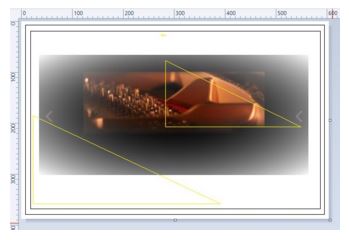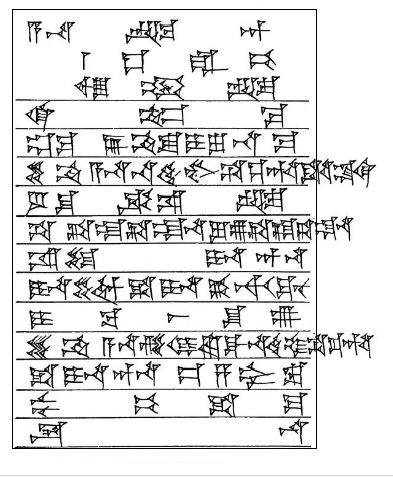
Mediterranea
A Journal of Cultural Anthropology and Ethnomusicology
( 3 /2017)
Monumenta
Dotium
Semiticarum

Le Lettere
di Sa-am-su-iluna

Studi preliminari
L.W. King, Letters and Inscriptions of Ḫammurabi, (Vol. III , London, Luzac and Company 1900).
https://archive.org/stream/cu31924104781285#page/n199/mode/2up
Publications of the Babylonian Section, Volume 1, Issue 2
Amazon.it: University of Pennsylvania University M.
Karen Radner, State Correspondence in the Ancient World
https://books.google.it/books?isbn=0199354774
Anson F. Rainey-William M. Schniedewind-Zipora Cochavi-Rainey, The El-Amarna Correspondence (2 vol.)
https://books.google.it/books?isbn=9004281541
A. Leo Oppenheim, Letters From Mesopotamia: Official, Business, and Private Letters
http://oi.uchicago.edu/research/publications/misc/letters-mesopotamia-official-business-and-private-letters-clay-tablets
Daniel David Luckenbill, Ancient Records of Assyria and Babylonia Volume 2
http://oi.uchicago.edu/research/publications/misc/ancient-records-assyria-and-babylonia-volume-2-historical-records-assyria

Directions for the supply of Corn
"še-am a-na na-kam-tim ša bīt ilu Šamaš ša Larsam"
Directions for the supply of Corn for the Temple of the Sun-God
Analisi redazionale, analisi retorico-strutturale e sintesi antropologico-culturale
di Davide Polovineo
April 11-12 2016
1 Analisi redazionale
"Sin-ilu, Bītu-rabi, and Nīḳ-Sin , to whom this letter is addressed, were probably high officials who looked after the collection of revenue in the district of Larsam. That they were something more than revenue-collectors may be inferred from the fact that the king writes to them personally; for the other royal letters in this volume are all addressed to officials of high rank. They are here ordered to hand over certain corn for the temple of the Sun-god, the delivery of which had been delayed" (L.W. KING, Letters and Inscriptions of Ḫammurabi, Vol. III, London, Luzac and Company 1900, p.120).
La House of Plenty del Sun-god di Larsam era un luogo cultuale importante nell'Old babylonian Period ed una fruttuosa impresa privata (private enterprise) della dinastia ḫammurapiana. E' necessario, in tal senso, richiamare un celebre studio di Marc van de Mieroop che presentando il Cultural Background dell'Old babylonian Period afferma: ".....tablets from the [Old Babylonian period] in general derive primarily from private archives, and therefore shed light on various private affairs such as inheritances, debts, marriages, ecc.. Information on the roles of the palace and the temples has to be gleaned from such documents, and the role of these institutions is clearly insufficiently represented. The Idea of the progression in Babylonia from temple dominated to palace dominated economies in the second half of the third millenium and the triumph of private enterprise in the early second millenium, was heavily influenced by the origin of the sources, and has been modified only recently" (M. VAN DE MIEROOP, Society and Enterprise in Old babylonian Ur, BBVO 12, Berlin 1992, 3). L'emergency regulation della private enterprise dell'House of Plenty del Sun God di Larsam è Identity System del grade of civilitation della dinastia ḫammurapiana (cfr.per la terminologia J. ASSMANN, La memoria culturale. Scrittura, ricordo e identità politica nelle grandi civiltà antiche, Torino 1997, p.122). Per questo la fonte Brit. Mus. No. 13, 936; pl. 84, No. 49 (Directions for the supply of corn for the Temple of the Sun-God in the City of Larsam) deve essere analizzata sinotticamente (cfr.le fonti Brit. Mus. No. 23,122 ; pl. 49; No.29; Brit.Mus. No. 23, 148; pl. 66; No.39; PBS 1/2 12 e YOS 2 113).
La formula d'indirizzo (formula a-na) ci permette di delineare un primo livello comparativo con la fonte Brit. Mus. No. 23,159, pl. 75, No.43 ( Directions for the restoration of a patesi to his former position): nella fonte è presente Sin-ilu. L.W. King afferma: "It would appear that the case of the patesi Sin-ilu has already formed the subject of correspondence between Sin-idinnam and the King. We may assume that Taribatum had complained to Ḫammurabi that Sin ilu had been taken from his service and handed over to the rīdūti, and from the present letter we learn that the King had written to Sin-idinnam ordering him to restore Sin-ilu to his former position. Sin-idinnam's reply to his request was to send Sin-ilu to Babylon, while he handed Sin-ilu's sons over to the rīdūti" (L.W. KING, Letters and Inscriptions of Ḫammurabi, p.107). PA-TE-SI (sumerian official title) è presente in Brit. Mus. No. 23,159, pl. 75, No.43 e Brit. Mus. No. 23,147; pl. 64; No.38 (Directions for the transfer of a PA-TE-SI to the service of another official) Brit. Mus. 12, 840, pl. 28, No. 17 (Warrant for the arrest of two governors and a soothsayer who were officials of the Palace Gate) mentre rīdūti (directors of the public slaves) è presente in Brit. Mus. 15, 848, pl. 43, No.26 (Directions concerning the restoration of certain men to their former employers), Brit. Mus. 12, 816, pl. 4, No. 3 , Brit. Mus. 12, 812; pl. 1, No. 1. Da un punto di vista redazionale, il titolo PA-TE-SI, probabilmente, è corrispondente al titolo accadico bitu-rabi [cfr. anche a livello comparativo il titolo bēl bīti accadico e b῾l bt ugaritico= capo famiglia ma anche reggente e/0 governante (CTA I [VI AB]: IV 6; 2 [III AB]: I 17; 6 [1 AB]: VI 57; 15 [III K]: IV 28; PRU V nr. 60,11.13.15.19 [cfr. anche A.SERI, Local Power in Old Babylonian Mesopotamia. Studies in Egyptology and the Ancient Near East, London 2005; cfr. J.C. DE MOOR, ba῾al in GLAT I 1435-1436; H.A. HOFFNER, baît, in GLAT I, 1275 ss; cfr. W.ROBERTSON-SMITH, Kinship and marriage, London 1885 per il Cultural background; cfr. anche A. SJÖBERG, Zu einigen Verwandschaftbezeichnungen im Sumerischen- Heidelberger Studien zum Alten Orient (1967) 201-231)]. E' necessario ricordare che, solitamente e retoricamente, Sa-am-su-iluna utilizzava il titolo bēl (cfr. PBS 1/2 12; PBS 1/2 13): nella nostra fonte il "titolo signorile" è assente.
La fonte Brit. Mus. No. 23,159, pl. 75, No. 43 ci permette di comprendere la delicata situazione che dovette affrontare Sa-am-su-iluna: per questo, la fonte Direction-Letter non è un testo d'immediata comprensione. E' necessario richiamare ancora il commento di King per la compresione dell'attante Sin ilu: "It is probable that Sin-idinnam was assured of the justice of his own case, but the present letter, in which he is reproved for what he has done, makes it clear that Ḫammurabi would not have his orders disobeyed" (L.W. KING, Letters and Inscriptions of Ḫammurabi, p.107). E' chiaro, infatti, che Sa-am-su-iluna conosceva la situazione e nella lettera utilizza la seguente fraseologia: i-na še-im ša i-na ga-ti-ku-n i-ba-aš-šu-u še-am a-na zi-mi ukullī na-kam-tum ša bīt ilu Šamaš ša i-na-na iz-za az-zu ub-bi-ša ma id-na.
Nelle formule idiomatiche delle International royal Direction-Letters, solitamente, la formula henceforth+in your hand è utilizzata per sottolineare l' "Identity System" feudale: ad esempio nella fonte ugaritica CAT 3.5 il testo recita: wa yatana-nni li baʻaluni bini kiliteni wa li wa li banihu ʻadi ʻalami šaḥra ʻalamta bunušu bunušima la yiqqaḥu-nni bidi ba ʻaluni bini kiliteni wa bidi banihu ʻadi ʻalami wa unuṯtu ina bihu (A partire da oggi / ʻAmmiṯtamru, figlio/ di Niqmepaʻ, re/ di Ugarit, ha dato / il terreno di Kušuḫdalu figlio di [ /..../ e li ha dati/ a Baʻalanu figlio/ di Kilitenu e ai / suoi figli, per sempre./ Nel futuro/ nessun uomo/ potrà prenderli dalle mani/ di Baʻalanu figlio di Kilitenu/ o dalle mani dei suoi figli, per sempre. Né tasse feudali/ vi sono in essi). E' interessante anche la fonte RS 16.166: " A partire da oggi/ Niqmaddu, figlio di ʻAmmiṯtamru/ re di Ugarit/ ha confiscato possedimenti e terre/ (poste) in Ullamu/ e le ha donate/ a Nuriyanu, suo fratello/ e ai suoi figli/ per sempre... Nessuno dalle/ mani di Nuriyanu/ o da quelle dei suoi figli/ potrà prenderle".
In tal senso si comprende l'importanza della formula Henceforth+ in your hand nella Direction-Letter di Sa-am-su-iluna che "riconferisce" il titolo di alto ufficiale a Sin-ilu dopo la vicenda ḫammurapiana (la formula henceforth+in your hand riconfigura l'Identity System templare). Per questo motivo, probabilmente, Sa-am-su-iluna scrive personalmente a Sin-ilu e Nīḳ-Sin:

bīt ilu (nomen regens)+ Šamaš è presente in Brit. Mus. No 23,148; pl 66; No. 39 (Summons of Temple- Officials to Babylon that they may render their Accounts); Brit. Mus. No. 26,959; pl. 156, No.83 (Letter to the Judges of Sippar concerning a Case which they have investigated) e in UET 5 81. King, scrupolosamente, afferma: "The nakamtu ša bīt Šamaš, or "Storehouse of the Temple of Šamaš", was probably one of the great Storehouse into which the Revenues of the Land were collected. The King himself controlled the Collection of both, the royal and the sacred Revenues, a fact which is proved by Letters from Ḫammurabi to Sin-idinnam, in which Instructions are given for Officers attached to the Service of the Temples to proceed to Babylon to render their Accounts to the King (L.W. KING, Letters and Inscriptions of Ḫammurabi, Vol. III, London, Luzac and Company 1900, p.120).
Il termine še-u è presente nelle seguenti fonti: = še-um /še-am in Brit. Mus. No. 23, 120 , pl.47, No. 28 (Order for the Payment of the Rent of certain Land); Brit. Mus. 12,821, pl. 9, No. 6 (Decree for the Restoration of Land illegally claimed by a Money-lender and Order for his Punishment); Brit. Mus. No. 12,830; pl. 20, No.12 (Order for the Restoration of certain Corn to its rightful Owner); Brit. Mus. No. 12,864; pl. 39, No.24 (Order for the Repayment of a loan of Corn with interest thereon), Brit. Mus. No. 23,145; pl. 63; No. 37 (An order for the Despatch of Corn to Babylon); Bu 91-5-9,340; pl. 95, No. 56 (Order for the Despatch of Corn when the Omens are favourable); Brit. Mus. No. 26,960, pl. 159, No.84 (Directions for the Harvesting of certain Corn); Brit. Mus. No. 26,961; pl. 161, No. 85.
2 Analisi retorico-strutturale: composizione
Gli elementi retorico-strutturali sono i seguenti:
še-am a-na na-kam-tim ša bīt ilu Šamaš ša Larsam
bušū Ig-mil- Sin
ša ta-at-ta-ad-na lu-u ta-at-ta-ad-na
iš-tu i-na-an-na
i-na še-im ša i-na ga-ti-ku-nu
še-am a-na zi-mi ukullī na-kam-tum ša bīt ilu Šamaš
ša i-na-na iz-za az-zu
ub-bi-ša ma
id-na
L'intera struttura è sorretta dall'elegante costruzione verbale ta-at-ta-ad-na lu-u ta-at-ta-ad-na (cfr. verbo nadanu I) e dalla raffinata costruzione verbale con id-na (in questo caso per id-na cfr. sempre verbo nadanu III). Per la composizione seguiamo la traduzioni di King:
Pertanto la struttura della lettera è ABA1: l'associazione lessicale The Corn +for the storehouse+ of the temple+ of Šamaš [House of Plenty (?) = storehouse: cfr. nakamtu in Brit. Mus. No. 13, 936 pl. 84 N0. 49 nakamtu ša bit Šamaš: cfr. anche Brit. Mus. No. 23,122 ; pl. 49; No.29; Brit.Mus. No. 23, 148; pl. 66; No.39) ed anche le costruzioni verbali con to give /to hand over/to deliver sono presenti in A e A1. Corn è il lessema fomdamentale che associa A-A1 a B.
3 Sintesi antropologico-culturale
Dalla composizione retorico-strutturale stessa si delinea una prima interpretazione: tutti gli attanti sono ufficiali dello Staatskapitalismus babilonese. "It is customary- afferma Oppenheim- to use this mine of information as evidence for or against "Staatkapitalismus" in Mesopotamia, or to point out the role and importance of private enteprise and the economic weight carried by clanlike or manorial organizations (temple or palace). I would rather see the evidence analyzed in relation to particular forms of economic integration rooted in specific landscapes, whose symbioses within given political units are largely responsible for the bewildering picture presented by the economic tablets from Mesopotamia". (A. L. OPPENHEIM, Letters from Mesopotamia, The University of Chicago Press, Chicago-London 1967, cit. p.4)
Tuttavia, per evitare la atomization of power (cfr. A. SERI, op. cit., p.54), Sa-am-su-iluna scrive personalmente al governante del tempio Sin-ilu che aveva vissuto una situazione conflittuale con i funzionari e gli amministratori del Royal System hammurapiano e con lo stesso Ḫammurapi. E' necessario sottolineare che l'Atomization of power è, probabilmente, il maggior problema del Royal System e dei private managers hammurapiani : "Possibly this new intermediate stratum of private managers- afferma Robert McC Adams- under some indeterminate forms of royal agreement can be usefully characterized as subalterns, a term reflecting their only partial equivalents in post-colonial India (cfr. CHATURVEDI VINAYAT ed., Mapping Subaltern Studies and the Postcolonial, London 200o). But these Babylonians are still only a dimly recognizable group to us, partly because of diversity of their activities; in particular, their relations with royal power need futher clarification". For those reason perhaps, Goddeeris introduces the term middle class only once, and then in quotes. Class of and for itself, as Marx saw, requires both coherence and self-consciousness. These Old Babylonian may not yet quite clearly enough have either. Let me instead take up the more stable and orderly ranks of local officials mentioned earlier, who probably were more or less coterminous in social background with these managers" (ROBERT McC ADAMS, Old Babylonian Networks of Urban Notables, Cuneiform Digital Libary Journal 2009:7, cit. p. 9). In effetti è proprio la middle class che prende "una brutta piega" nel periodo di Sa-am-su-iluna: si destabilizza l'ancestrale interazione continua e il riconoscimento non "solo del mio" e del tuo" ma anche della proprietà e degli interessi di terze persone "non presenti al momento" (W.BURKERT, La creazione del sacro. Orme biologiche nell'esperienza religiosa, Milano 2003, p. 114-115).
|